Based on an increasing pool of scientific evidence, it is likely Mars was once “covered by oceans and lakes and was layered by a thick atmosphere, very much similar to Earth.”[1] In addition, per scientific studies, Mars had all the ingredients necessary for life: an abundance of water, an energy source, sufficient presence of carbon, hydrogen, nitrogen, oxygen, and phosphorous, all with the proper “atomic charge” and a stable environment capable of supporting life for at least a billion years.
In fact the ancient Martian environment was “so benign… and supportive of life… you would have been able to drink it[s] [water],” Curiosity project scientist John Grotzinger, California Institute of Technology (Pasadena, CA) stated in 2013[2] based on Curiosity Rover’s findings that Gale Crater once held a “fresh water lake (containing key biological elements including carbon, hydrogen, oxygen, nitrogen, and sulfur)… that may have existed for hundreds of thousands of years.”[3]
And with all the ingredients of life in place and a growing body of photographed Martian artifacts exhibiting properties and characteristics consistent with artificial creation, it is likely Mars was once home to an intelligent civilization that may have developed at or around the same time as life on Earth some 3.5 billion years ago.
Trinitite depicted in green as detected by NASA’s Mars Reconnaissance Orbiter (right)
However, about 180 million years ago, the planet’s civilization was completely wiped out by a thermonuclear event (which may have consisted of two powerful explosions) that was so massive, it “produc[ed] a global debris pattern with a shock wave wrapping around the [entire] planet…[that] collid[ed] with itself at the approximate antipode,”[4] completely incinerating its atmosphere, instantly vaporizing every living creature as well as the planet’s vast oceans and abundant lakes, causing catastrophic crustal displacement and bleaching of its soil and rocks in a permanent red. Consequently, Mars was rendered a lifeless and uninhabitable planet.
The presence of uranium, thorium and radioactive potassium on the Martian surface, the “high concentration of xenon-129, uranium and thorium found in the Martian atmosphere” based on analysis from the Odyssey spacecraft as well as the presence of “nuclear melt-glass Trinitite”[5] based on “data from the instrument Compact Reconnaissance Imaging Spectrometer for Mars (CRISM) on NASA’s Mars Reconnaissance Orbiter”[6] confirm the extinction event massive nuclear explosions.
Accordingly, since the extinction-event nuclear explosions and subsequent radioactive contamination destroyed the planet’s biological compounds, including organic carbon, the paradigm for the search for past intelligent life must be modified since sole reliance on discovery of possible organic signatures is badly flawed. Considering that radioactive potassium has a half-life (how quickly an unstable atom decays and loses half its radioactivity) of 1.25 billion years, Uranium-235 has a half-life of 700 million years, Uranium-238 a half-life of 4.47 billion years, and thorium-90 a half-life of 14.05 billion years (in contrast the Earth is 4.543 billion years old) such searches are unlikely to yield significant results. Consequently the search for past intelligent life must focus on photographic documentation of discovered artifacts based on methodological parameters that can determine they were likely created artificially, the focus of this article.
Even though virtually every trace of Martian civilization including infrastructure and artifacts were obliterated, a few scant traces have survived and are now emerging and being discovered as NASA’s Rovers explore the planet’s surface, attesting to the real likelihood that intelligent extraterrestrial life had once existed on Mars. Furthermore, as it once existed on Mars, presently exists on Earth, it is likely that it exists elsewhere in the universes especially when the Fermi paradox is considered: “There are billions of stars in the galaxy that are similar to the Sun, many of which are billions of years older than Earth. With high probability, some of these stars will have Earth-like planets, and if the Earth is typical, some might develop intelligent life.”[7]
Per U.S. author Richard C. Hoagland, “All we see are ruins… literally thousands of square miles… of ruins. And, a lot of mud covering them… slowly eroding and blowing away in the wind… [w]hich is why we can now see glimpses [of] what was once buried in a vast, planetary catastrophe [that] suddenly ended the Martian Civilization.”[8]
Furthermore as artifacts are being discovered and photographed, a picture of the intelligent life that had once inhabited Mars is emerging. Though very preliminary at this stage, it appears that Martian civilization at the very minimum exhibited characteristics of ancient Egyptian and Mesoamerican civilizations, may have utilized a system of pictographic/petroglyphic writing, must have used tools (based on the precise geometric and detailed properties of some of the artifacts), created artificial structures and held a system of religious beliefs (possibly monotheistic) that included an afterlife. It also appears Martians were face-centric – more interested in depicting faces than full body works, possibly because cognitive abilities were held in higher esteem than physical abilities within their culture.
The following methodology was used when selecting and discussing photographed artifacts:
1. Object(s) must have clear properties and characteristics consistent with artificial creation. This can be determined by geometric properties (e.g. degree of shape, symmetry), associated attributes (e.g. color/shading, specific texture), and relationships (e.g. detail placement on the object, differences in the general characteristics of the object vs. local characteristics attributed to the site).
2. Object(s) when considering heavy erosion by the planet’s hostile conditions over the last 180 million years (which explains the limited number of artifacts since most have long since crumbled into dust if they had not been destroyed by the massive thermonuclear event) must have distinct features that are considerably different than the surrounding landscape to ensure they cannot be attributable to pareidolia.
3. The artificiality hypothesis will be used with re: to faces such that they should exhibit more than mere primary features. Secondary features such as eyebrows, pupils, lips, nostrils, etc. should be seen at a higher resolution if attributable to artificial origin; if attributable to natural origin they would appear more fractal at a higher resolution. Depth and 3D properties must also be present in photographed objects.
4. 3D graphics and photo enhancement (limited to coloring and sharpening) may be used when possible to bring out critical details that may be missed.
5. Astronomical calculations may be used in some cases to see if the object(s) are aligned to astronomical events or bodies to further demonstrate intelligent reasoning behind their design.
2. Object(s) when considering heavy erosion by the planet’s hostile conditions over the last 180 million years (which explains the limited number of artifacts since most have long since crumbled into dust if they had not been destroyed by the massive thermonuclear event) must have distinct features that are considerably different than the surrounding landscape to ensure they cannot be attributable to pareidolia.
3. The artificiality hypothesis will be used with re: to faces such that they should exhibit more than mere primary features. Secondary features such as eyebrows, pupils, lips, nostrils, etc. should be seen at a higher resolution if attributable to artificial origin; if attributable to natural origin they would appear more fractal at a higher resolution. Depth and 3D properties must also be present in photographed objects.
4. 3D graphics and photo enhancement (limited to coloring and sharpening) may be used when possible to bring out critical details that may be missed.
5. Astronomical calculations may be used in some cases to see if the object(s) are aligned to astronomical events or bodies to further demonstrate intelligent reasoning behind their design.
It must also be noted that artifacts must resemble ancient objects since the Martian surface has already been polluted with the remains of modern Earth technology starting with the crash of the USSR’s Mars 2 probe on November 27, 1971. As a result the axle and pair of wheels captured by Curiosity Rover in PIA 16453 in November 2012 are not considered. It is likely these wheels are the remains of one of the many Martian probes that had failed.
At the same time since Martian artifacts can only be viewed through aerial and surface photographs rather than through direct physical examination since the planet’s archeological sites some 250 million miles from Earth remain inaccessible to human visits, some limitations exist especially due to lighting conditions and angles that can obscure and/or mislead due to resulting shadows. Nevertheless, photographic archeology does provide an impartial and reliable visual record based on contextual setting (e.g. location – “place where the artifact is found or in relation to,”[9] site type, geological conditions, lighting, etc.). Consequently, even though direct physical examination of Martian artifacts is not possible and the quantity remains very limited, likely due to thermonuclear obliteration and the long passage of time (180+ million years), a few artifacts do pass the muster of having an artificial origin based on the above methodology. As a result they provide a “direct [but] fragmentary”[10] link to the Martian past. These artifacts along with direct hyperlinks to NASA photographs are presented below.
The Elongated Skull:
On September 14, 2014 Curiosity Rover photographed an object that appears to be an elongated skull, which in spite of being caked in surface dust retains features that are noticeably distinct from the surrounding surface and nearby rocks. It is also darker in color indicating its composition is different from that of the nearby Martian rocks despite the affects of fossilization.
Per MOR: The Process of Paleontology, “…Often, fossils take on the color of the rock in which they were buried making them more difficult to identify. Occasionally [they] stand out because of their color… [which] is darker than the surrounding rocks.”[11]
However, it must be noted that at times a fossilized skull may resemble or at least share characteristics of rocks as shown by the Antiques.com skull (right) that has lost many of its signature characteristics due to the fossilization process.
Based on these findings, it appears that Martian anatomy included an elongated skull for enhanced cognitive abilities and perhaps a smaller body:head ratio than Homo sapiens on Earth. This may be further corroborated by the fact that it appears Martians were more interested in depicting faces than bodies based on discovered sculptures and rock fragments.
Consequently if this is indeed a Martian skull, then they may have resembled the following public domain depiction:
PIA 17931: An Historically Important Photograph:
On January 30, 2014 Curiosity Rover snapped a photograph of Dingo Gap (PIA 17931), an historically important photograph of the Martian surface not only because it consisted of two (possibly three) significant discoveries that provide compelling evidence for the past existence of an intelligent Martian civilization but because it corroborated Spirit Rover’s 2006 capture of two Martian artifacts and in doing so enhanced the probability that such artifacts are very real and do in fact exist on the Martian surface.
PIA 17931 consists of a half-face (the upper section exhibits distinct features while the lower section is obscured by a dark shadow such that no features are visible) that resembles sculptures created by the Toltec society, a c. 800-1000 CE Mesoamerican culture in the Tula region of Mexico, the remains of a clearly delineable ancient building foundation, and a possible broken bas-relief depicting two humanoid figures and an equine-like figure.
With regard to the face (referred to as the Toltec Face), its humanoid features are amazingly distinct and clear. They are completely inconsistent with surface and nearby rock patterns. Secondary features such as lips and eyelids are clearly visible upon magnification providing convincing evidence that it was created by artificial means.
“Toltec” Face (left) and 3D bilateral symmetrical model (right)
Objects close to the Toltec face that resemble broken slabs also appear to have been artificially created based on their smooth, precise cutting and contrast with nearby rocks.
Second, the remains of a partially-buried ancient building foundation that appears to have been constructed out of flat concrete/rock slabs provides further evidence of artificial design by an intelligent species due to their precise geometric design, pair of right angles and smooth texture that vividly stand out in stark contrast to nearby surface and rock patterns.
Objects close to the Toltec face that resemble broken slabs also appear to have been artificially created based on their smooth, precise cutting and contrast with nearby rocks.
Second, the remains of a partially-buried ancient building foundation that appears to have been constructed out of flat concrete/rock slabs provides further evidence of artificial design by an intelligent species due to their precise geometric design, pair of right angles and smooth texture that vividly stand out in stark contrast to nearby surface and rock patterns.
Partially buried Ancient Building Foundation
Third, what appears to be a broken architectural bas-relief is also located in close proximity to the Toltec Face and partially buried foundation. However because of clarity issues and lighting patterns, pareidolia may play a role in its imagery and one cannot conclusively state with much of a level of confidence that it was created by artificial means or actually depicts what it appears to. This image was merely included since it is intriguing and located near two significant archaeological Martian finds.
Third, what appears to be a broken architectural bas-relief is also located in close proximity to the Toltec Face and partially buried foundation. However because of clarity issues and lighting patterns, pareidolia may play a role in its imagery and one cannot conclusively state with much of a level of confidence that it was created by artificial means or actually depicts what it appears to. This image was merely included since it is intriguing and located near two significant archaeological Martian finds.
Gusev Crater Face:
Thirty years after Viking I had snapped a photograph (#035A72) of what appeared to be a face in the Cydonia region of Mars on July 25, 1976 that turned out to be an optical illusion and the result of pareidolia based on subsequent 2001 and 2007 photos by Mars Global Surveyor and Mars Reconnaissance Orbiter, respectively, Spirit Rover captured a photograph of the remains of two Martian artifacts near Gusev Crater, named after Russian astronomer Matvey Matveyevich Gusev (1826-1866), in what is called “McMurdo” Panorama (PIA 01907) on October 25, 2006.
Unlike the Cydonia face that consisted solely of two-dimensional primary facial features (it lacked secondary features and the only 3D aspect of the image was the mesa’s topography), a nostril hole that was the result of a data error (the black dots in the Viking I photo were data errors), and was partially shrouded by a dark shadow that appeared to add depth to its features, the newly found Martian artifacts were better illuminated such that there were no shadows over critical features, they exhibited 3D characteristics and significant differentiation from the nearby surface area and rocks such that they could not be the results of an illusion. Consequently, PIA 01907 likely consists of the first discovered real archeological evidence of a past, intelligent Martian civilization.
When the face, referred to as the Gusev Crater Face, which features female characteristics and an elongated head perhaps corroborating Martian anatomy based on the elongated skull and elongated Toltec Face (both discussed above) is examined upon magnification there are clear indications that it was artificially created. The right half of the volcanic rock is smooth – a characteristic that is inconsistent with volcanic rock – and it consists of a well-defined nose, nostrils and lips. Because of its refined details that cannot be attributed to shadows since the facial features are fully illuminated and its 3D nature, the Gusev Crater Face cannot be an illusion of pareidolia.
In addition, the clear carving and smooth texture of the Gusev Crater Face are inconsistent with all the other volcanic rocks that litter the Martian surface near Spirit Rover such that there is a high degree of probability that it was meticulously created by an intelligent species. It is not likely that natural elements were responsible for the smooth surface especially since it only exists where the facial features are located and none of the nearby rocks have smooth surface areas, which should be the case if geological and meteorological conditions were responsible. Furthermore facial features are located in the correct areas and are of the proper dimension while the nose and lips are fully and accurately defined.
At the same time, the interesting find of a broken plate-like object (fully illuminated) with a perfect arc-like etching that appears to be of artificial design further enhances the prospects of past life in and around the Gusev Crater region. The broken plate-like object also appears to have been carved from volcanic rock based on its color and texture, both of which match the smooth sections of the Gusev Crater Face. Again there can be no natural explanation for the broken plate’s smooth texture especially because of the existence of perfect geometric circular etching and its raised, even edge.
It should also be noted, scientific findings from Spirit Rover further enhance the prospects of past life in and around the Gusev Crater region. In 2004 Spirit Rover determined that “water (an essential ingredient for life) thoroughly altered some rocks in… Gusev Crater.”[12] "We have evidence that interaction with liquid water changed the[ir] composition…" stated Steve Squyres, Ph.D., Cornell University (Ithaca, NY), the principal investigator for the science instruments on the Opportunity and Spirit Rovers. He also suggested Gusev Crater used to have larger amounts of liquid water than the nearby plain. Such water was also likely present all year round in what can be called “Lake Gusev”[13] based on analyzed samples from a rock named, “Mazatzal” that “indicates a scenario where water froze and melted” in annual cycles “at some point in Martian history.”[14]
It is highly probable the Toltec and Gusev Crater faces retained many of their details since they were likely buried for a significant amount of time and thus protected from erosion caused by the harsh Martian elements. Consequently future exploration may not be possible since these artifacts, which had been photographed at the right moment, will likely degrade with the passage of time.
Finally in regard to the Gusev Crater Face, the “combined odds against [it exhibiting] all of [its] features (each is at the expected location, their size, shape, dimensions, orientation are consistent with facial anatomy, the presence of distinct secondary features upon magnification) and having all expected characteristics to the degree actually present, when taken together with the absence of similar features in the background (rocks and ground surface), exceed a thousand billion billion to one (1021 to 1)” such that artificiality is “the most reasonable explanation” for its creation.[15]
Martian Pyramid and Ring of Rocks:
On May 7, 2015 Curiosity Rover captured a photograph of a four-sided small Martian pyramid that is approximately 5-8 feet tall. Although small in size, this pyramid consists of “near perfect design and shape,” precise geometric form, and stunning symmetry.[16]
At the same time, when the surrounding landscape is viewed, there are no other pyramidal formations. In addition, its morphology and form are inconsistent with the other geological formations including the boulder with a smoothed left side and slab-like rock located on the right side of the photograph such that it is unlikely to be the creation of natural geological phenomena.
In short, it appears that this pyramid is “likely the ‘result of [artificial], intelligent design and certainly not [the product] of light and shadow’” or pareidolia,[17] providing compelling “photographic evidence… that artificial structures exist on Mars built by an earlier civilization.”[18]
A year earlier, on January 29, 2014 Curiosity Rover captured four images featuring a ring of rocks. When one considers the rocks form a perfect circle and are not the product of an optical illusion since each of Curiosity Rover’s photographs were taken from a different angle the most likely explanation is they were consciously and deliberately arranged in that formation by an intelligent civilization.
Natural phenomena alone cannot account for such perfect geometry with precise 360°angles, especially since the circular formation is completely inconsistent with nearby as well as planetary-wide rock and surface patterns.
Finally in regard to the Martian Pyramid and Ring of Rocks, the probability of natural phenomena creating perfect geometric shapes in spite of the infinite possibilities is merely infinitesimally above zero. Per Ion Saliu, author of Probability Theory, Live! (2012) – “[T]he Universe [and] [n]ature… prefer everything not predictable with absolute certainty. …Randomness is the fundamental rule… Only… intelligent life… attempts at creating perfect shapes or geometric shapes [where] the next element tends to be predictable with absolute certainty… Where ever self-aware intelligence exists, perfect shapes exist as well.”[19]
Column Petroglyph:
The petroglyph on a partially buried and broken column photographed by Curiosity Rover on August 21, 2014 appears to consist of a stick figure and three symmetrical lines consistent with columns created on Earth.
Even though the bottom portion appears to be mere weathered rock sans texture, pareidolia may not be an issue when one considers what appears to be another broken column (see circular image on the far right) with six equal sides and a concave bowl-like top with possible petroglyphic patterns that was also photographed by Curiosity Rover. Together, each corroborates the other as the possible creations of a past intelligent civilization.
At the same time, even though the raised stick figure raises some issues with regard to artificiality considering the task requires greater effort, there is precedent for raised petroglyphs on Earth based on discovered samples in New Mexico, Wyoming, and the Valcamonica region in Italy to name just a few sites. As a result, when one considers the stick figure design, the clear dimensions of the head, placement of body parts and the three symmetrical lines, it remains a distinct possibility this is a valid artifact depicting Martian writing.
Martian Cross:
On January 10, 2014 Curiosity Rover captured an image featuring a cross and ornate broken roof slabs, an image so profound it challenges our perspective on social order and religion, namely our anthropocentric outlook in which humans are viewed as the pinnacle of intelligent life and the sole object of divine salvation by many. In fact this image was so profound and intriguing Curiosity Rover returned to the same area and captured a second image of the cross on March 7, 2014 from a slightly different angle that revealed the existence of a partially buried nearby building foundation.
The second image not only confirms that the cross is very real based on its 3D characteristics but that it was likely and willfully created by an intelligent species with a belief in the afterlife especially when the nearby building foundation consisting of perfect straight-line geometry and a precise 90° angle is considered.
At the same time, the second image indicates the cross was created from an unknown wood- like composite with properties similar to plastic since it has endured for over 180 million years.
When these two photos are considered, the Greek concept of time – Kαιρός (Kairos), known as metaphysical or Divine time that is qualitative vs. quantitative in nature must be considered bolstering views by Gottried Leibniz (1646-1716) and Immanuel Kant (1724-1802) that “space and time ‘do not exist in and of themselves, but… are the product of the way we represent things” and time is “an abstract conceptual framework, together with space and number[s], within which we sequence events, quantify their duration, and compare motions of objects,” respectively.[20] Crucifixions could not possibly be occurring over and over again all across the universes since this would be sadism instead of love. Rather the crucifixion occurred only once due to metaphysical time and Divine omnipresence.
The presence of the Martian cross indicates the crucifixion is more universal than thought and likely occurred on Mars more than 180 million years before the birth Christ here on Earth based on our Χρόνος (Chronos) or linear concept of time. In addition, from a theological view, it appears that salvation was and is being brought to every inhabited world in the universes such that from a Divine perspective we are simply among a race of intelligent species subject to the same agape love and promise of eternal life without preference.
Additional evidence of the existence of a past, intelligent civilization on Mars is also indicated by the presence of the broken roof slabs consisting of several straight line ridges and intricate ornate carvings found to the distant right of the Martian cross.
With that said, religion should survive since these findings do not negate their fundamental aspects: God is the Creator, God is love [1 John 4:16] and He is the Savior. We merely have to accept the fact that His love is not selfish and limited to us alone and learn to accept that He shares it with each and every being of His creation.
Conclusion:
It appears that 2006 marked an epochal moment in human history – the moment we confirmed the existence of a past advanced civilization on another planet based on the discovered and photographed Martian artifacts which consist of 3D dimensions, appear to have a purpose, exhibit precise geometric aspects, are non-random based on their sharp divergence from surrounding geological formations and surface morphology and location in areas conducive to having once supported life due to the presence of water and other favorable conditions. Considering that intelligent life had once existed on Mars, one may extrapolate and state with certainty that it is likely to exist elsewhere in the universe, especially based on the Fermi paradox. Thus in all probability the age-old question has been answered, “We are not alone and probably never were!”
______________
Note: All photographs taken by NASA except three public domain images: Artist's Conception of Mars, Martian Depiction, and 3D Bilateral Symmetrical Model of the Toltec Face.
NASA Photograph Hyperlinks:
1. Elongated Skull: mars.jpl.nasa.gov/msl-raw-images/msss/00711/mcam/0711ML0030270000304691E01_DXXX.jpg
2. PIA 17931 – An Historically Significant Photo: photojournal.jpl.nasa.gov/jpeg/PIA17931.jpg
3. Gusev Face (PIA 01907): photojournal.jpl.nasa.gov/jpeg/PIA01907.jpg
4. Martian Pyramid: mars.nasa.gov/msl/multimedia/raw/?rawid=0978MR0043250040502821E01_DXXX&s=978
5. Ring of Rocks: mars.jpl.nasa.gov/msl/multimedia/raw/?rawid=NRB_444283159EDR_F0260000NCAM00251M_&s=527
6. Column Petroglyph: mars.jpl.nasa.gov/msl-raw-images/msss/00735/mcam/0735MR0031500000403075E01_DXXX.jpg
7. Broken 6-sided Column: mars.jpl.nasa.gov/msl-raw-images/msss/01049/mcam/1049ML0046190040306064E01_DXXX.jpg
8. Martian Cross and Ornate Roof Slabs: mars.nasa.gov/msl/multimedia/raw/?rawid=0508MR2000030000E1_DXXX&s=508
9. Martian Cross (Image 2): mars.nasa.gov/msl/multimedia/raw/?rawid=0563ML0022780000204657E01_DXXX&s=563
______________
Additional Sources:
A. Gruen, ed. et al. Automatic Extraction of Man-Made Objects from Aerial and Space Images (II). Springer Basel Ag. Basel, Switzerland. 1997.
Marc Kaufman. Mars Rover Finds Stronger Potential for Life. The New York Times. 8 December 2014. www.nytimes.com/2014/12/09/science/-stronger-signs-of-life-on-mars.html?_r=0
Minhwan Kim et al. Natural/Man-Made Object Classification Based on Gabor Characteristics. Springer Link. 2005.
Artifact (archaeology). Wikipedia. 31 March 2016. en.wikipedia.org/wiki/Artifact_(archaeology)
______________
Endnotes:
[1] Tibi Piui. Mars covered in oceans of water: how the red planet might have look billions of years ago [FANTASTIC PHOTOS]. ZME Science. 2014. www.zmescience.com/science/care-to-guess-what-this-picture-is
[2] Elizabeth Landau. NASA: Yes, Mars could have hosted life. CNN. 12 March 2013. lightyears.blogs.cnn.com/2013/03/12/nasa-yes-mars-could-have-hosted-life
[3] Ellie Zolfagharifard. Ancient fresh water lake on Mars suggests life may have flourished on the red planet 3.6 billion years ago. Daily Mail. 9 December 2013. www.dailymail.co.uk/sciencetech/article-2520829/Life-Mars-existed-3-6-billion-years-ago.html
[4] 46th Lunar and Planetary Science Conference (2015). 22 April 2016. www.hou.usra.edu/meetings/lpsc2015/pdf/2660.pdf
[5] Jonathan O’Callaghan. Were Martians wiped out by a nuclear bomb? Physicist to present new evidence for bizarre theory at Nasa Conference. Mail Online. 17 March 2015. www.dailymail.co.uk/sciencetech/article-2998835/Were-Martians-wiped-nuclear-bomb-Physicist-present-new-evidence-bizarre-theory-Nasa-conference.html
[6] NASA Spacecraft Detects Impact Glass on Surface of Mars. Release 15-118. NASA. 8 June 2015. www.nasa.gov/press-release/nasa-spacecraft-detects-impact-glass-on-surface-of-mars
[7] Fermi paradox. Wikipedia. 20 April 2016. en.wikipedia.org/wiki/Fermi_paradox
[8] New data, law of evidence support view of Mars having indigenous, intelligent extraterrestrial life. 21 April 2016. exopolitics.blogs.com/exopolitics/2011/12/new-data-law-of-evidence-support-view-of-mars-having-indigenous-intelligent-extraterrestrial-life.html
[9] Take Only Pictures: The Importance of Context in Archeology. FPAN. 19 April 2013. www.flpublicarchaeology.org/blog/ncrc/2011/04/19/take-only-pictures-the-importance-of-context-in-archaeology
[10] Take Only Pictures: The Importance of Context in Archeology. FPAN. 19 April 2013. www.flpublicarchaeology.org/blog/ncrc/2011/04/19/take-only-pictures-the-importance-of-context-in-archaeology
[11] MOR: The Process of Paleontology. 25 April 2016. museumoftherockies.org/uploads/Resources/Trunks__Kits/Background_Info-Process_of_Paleontology.pdf
[12] Bedrock in Mars’ Gusev Crater Hints at Watery Past. NASA. 8 August 2004. www.nasa.gov/vision/universe/solarsystem/mer-081804.html
[13] Gusev Crater once held a lake after all, scientist says. Science Daily. 9 April 2014. www.sciencedaily.com/releases/2014/04/140409155744.htm
[14] Tony Fitzpatrick. WUSTL Mars team describes water detection at Gusev crater. 22 September 2005. source.wustl.edu/2005/09/wustl-mars-team-describes-water-detection-at-gusev-crater
[15] Tom Van Flandern. Proof that the Cydonia Face on Mars is Artificial. Meta Research. June 2015. metaresearch.org/solar%20system/cydonia/proof_files/proof.asp
[16] Mars Pyramid Seen By NASA Rover Isn’t Quite What It Seems. Huffington Post. 26 June 2015.
www.huffingtonpost.com/2015/06/26/mars-pyramid-nasa-curiosity-rover-video_n_7665080.html
[17] Mars Pyramid Seen By NASA Rover Isn’t Quite What It Seems. Huffington Post. 26 June 2015.
www.huffingtonpost.com/2015/06/26/mars-pyramid-nasa-curiosity-rover-video_n_7665080.html
[18] NASA Curiosity Rover Photographs Pyramid on Mars. Exopolitics.org. 20 June 2015.
exopolitics.org/nasa-curiosity-rover-photographs-pyramid-on-mars
[19] Ion Saliu. Perfect or Geometrical Shapes on Earth, in Nature, Universe. 1 September 2002. saliu.com/bbs/messages/636.html
[20] Time. Wikipedia. 20 April 2016. en.wikipedia.org/wiki/Time
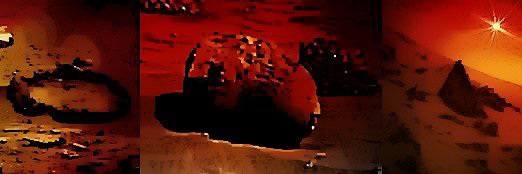



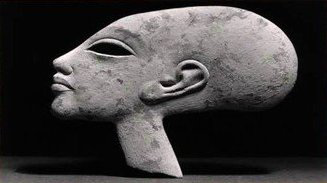

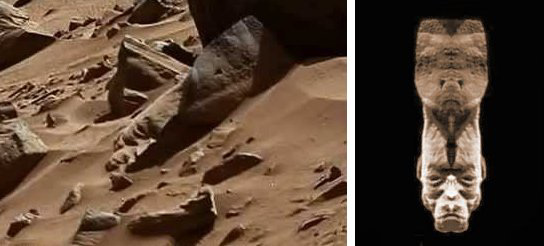


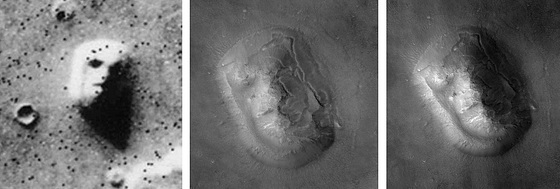
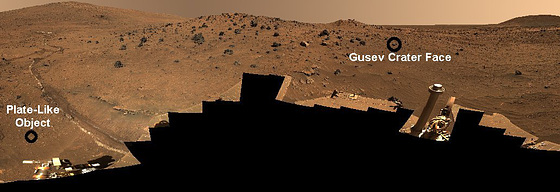
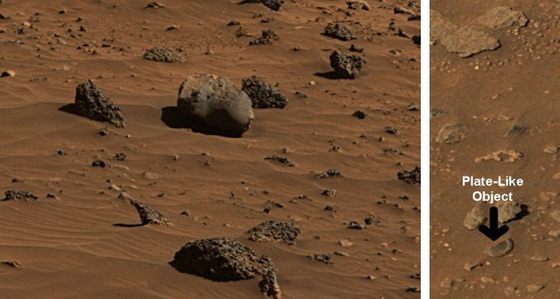
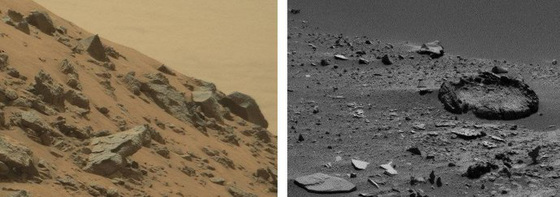
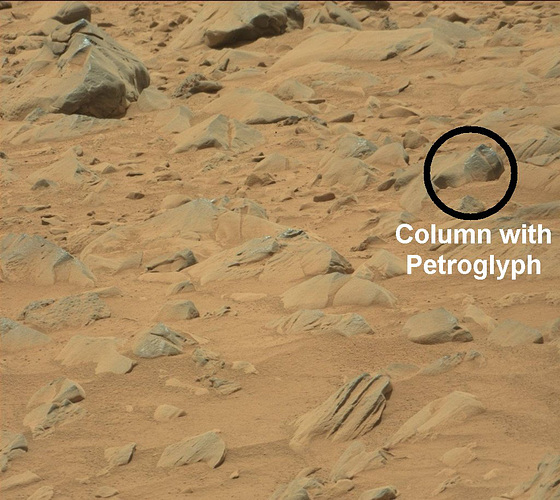
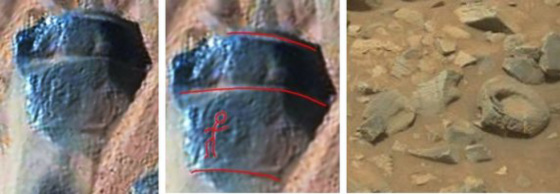
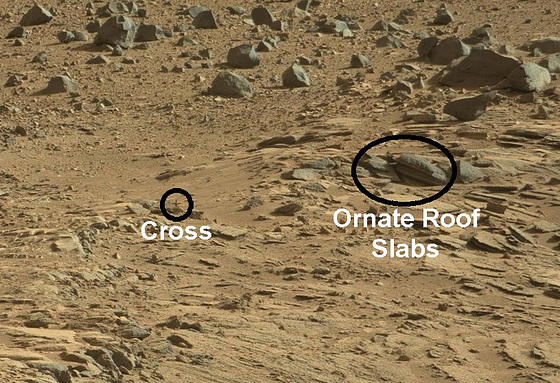
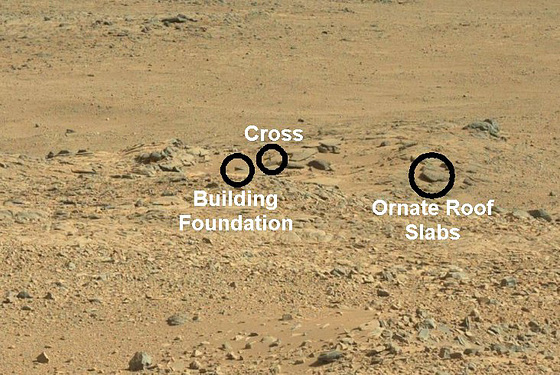
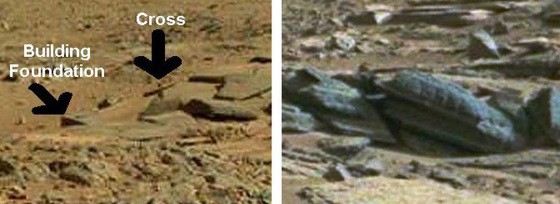
30 comments
Pam J said:
You can see pictures in clouds too... that doesnt make them evidence of "intelligent" life.
That Mars had a different climate is fine.. but "Quatermass and The Pit" never happened.
I find it sad that supposed sighting become "science fact" .
But then.... these same people probably thing the Moon is made of cream cheese.. and that the Moon landings never happened... but that is a whole new path !
Just so sad that real discovery and wonderful science is being so corrupted.
William Sutherland said:
I think some of these examples are very intriguing and could be evidence of past intelligent life. The problem is there are so-many "sensational" sightings that discredit serious attempts to seek archeological/paleontological evidence.
Actually based on a 2005 Smithsonian article if the same rigid standards were used on Earth re: Martian artifacts then the earliest known fossils would be discredited simply as natural rock formations without a biological origin. The same would have to go for some of the ruins of ancient pueblos.
Finally, I don't say it's a science "fact" but the evidence of a few items is compelling such that the past existence of intelligent life on Mars cannot be dismissed. It's unfortunate the government here has neglected the space program for years. One can only hope eventually the space program takes its turn in the spotlight.
Blue rubber octopus said:
Stormlizard said:
But yes, it is very likely and yes there are bound to be other planets in as yet unknown systems where life of some form or other did or perhaps even still does exist, we are highly unlikely to meet these non terstrial beings. We already know of life forms here on Earth that in the past were considered to be impossible. So taking these into the quetion means that Inteligent life does not have to be an upight two legged being similar to ourselves, also remembering that other creatures show certain levels of inteligence such as Crows and other Corvids, extremely quick to solve problems and to utiliize tools to aid their search for food.
It was once put forward by a scientist that very little would be required for a creature such as the Velocoraptor to have evlved into a major competitor to ourselves.
William Sutherland replied to Stormlizard:
Taormina said:
but I think that all these are just coincidences ...
eyes deceive the mind.
William Sutherland replied to Taormina:
William Sutherland said:
Stormlizard replied to William Sutherland:
Stormlizard replied to :
It has been said that there is only one ossible chance of the entire human race joining forces without predjudice, if/when we are attacked by Aliens, however once we had defeated those invaders things would quickly revert to Status Quo.
Taormina replied to :
This includes the pyramids of Egypt.
The climate and especially the winds on Mars are quite different than on Earth ...
making this the course of the year with a stone, we can not imagine.
Maybe that's what you see there.
believes to see.
... Just what have allowed other back ?!
We humans left there also something found "other" maybe once.
"Bad" that we have not only objects go there also,
but in all likelihood, microbes and bacteria.
William Sutherland replied to :
As for things we can't explain, I can only hope the pace and scope of research is expanded to give clearer answers and verifying corroboration. There's still so much to learn here about our world as well as other planets and the universe.
William Sutherland said:
William Sutherland said:
Taormina replied to :